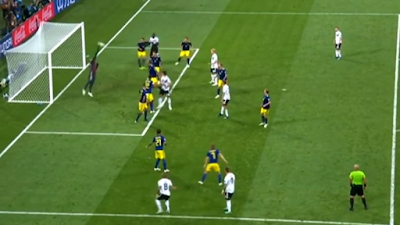The view from behind the goal shows what the Swedish goalkeeper had in mind (click on the image for a larger view).
He is protecting the part of the goal to his right, perhaps thinking the Swedish two-player wall and other defenders would be enough to keep the Kroos kick out of the part of the goal to his left. One of the defenders in the Swedish wall actually flinched away from Kroos' kick! Check that out below (click on the image for a larger view).
See the blur of the ball on the back of the Swedish defender at the bottom of the image? Hey, I'd flinch, too, with a fast-moving ball coming right at me, but I bet they guy wishes his back had at least let the ball graze him.
Now it's time to look at the beautiful trajectory. The Magnus force helped Germany win the match because Kroos put a lot of counterclockwise (as seen from above) spin on the ball by kicking the ball right of center with his right boot. That led to a Magnus force pushing the ball to Kroos' left, which meant the goalkeeper might have thought the ball would be wide of the goal. Check out the trajectory that I've labeled with circles below (click on the image for a larger view).
Look at the lovely bend! That's a banana kick with whipped air! As the ball spins counterclockwise, the boundary layer of air is being whipped off the back right part of the ball. If the ball whips the air that way, Newton's third law says the air has to push the ball to the left. And did it ever! Check out the view of the bend from a lower angle (click on the image for a larger view).
Air resistance worked to slow down the ball and Earth's gravity pulled the ball downward, but that gorgeous bend is due to the Magnus effect. Want to see how close the Swedish goalkeeper came to deflecting the ball? Check it out (click on the image for a larger view).
See the ball just barely off his outstretched right hand? Want another view? Sorry, Sweden, but I've got to show it (click on the image for a larger view).
The image will surely give Swedish fans heartache, but sometimes the beautiful game comes down to mere inches.
Okay, let's get quantitative. I know the aerodynamic properties of Telstar 18 (click here for my research paper). Modifying the result in my paper with what we've learned about spinning balls, I modeled Kroos' kick. Check out the trajectory plot below, which shows the trajectory in red (dashed red line is the shadow on the pitch) and what the trajectory would have looked like without the Magnus force in blue (dashed blue line is the shadow on the pitch). The goal plane is also shown (click on the image for a larger view).
The perspective I have on my 3D plot isn't quite the same on the actual views I showed above, which is why the red trajectory doesn't look quite as curved as the trajectories I put on the actual images. Television images are also a bit skewed. But you can see how much the Magnus effect altered the trajectory from the no-spin case.
The ball was kicked at 67 mph at about 13.6 degrees above the horizontal. The ball was travelling a bit more than 51 mph when it reached the goal plane, having been slowed by air resistance and converting some kinetic energy into gravitational potential energy.
I'll now show you the sizes of the drag force and the Magnus force on Kroos' kicked ball while in flight. I scale the forces by the ball's weight. The ball took almost a second to reach the goal plane (click on the image for a larger view).
Look how close to the ball's weight the two forces are at the moment the ball was kicked! You can see why the ball slowed so much and curved so much on its way to the goal plane. Had there been no air resistance, the ball would only have slowed 1 mph or so at the height it reached in the goal plane.
I loved watching the kick and I loved analyzing the kick. Physics makes the beautiful game all the more beautiful!










Thanks for sharing your qualitative and quantitative assessment of physics behind Kroos's kick. I am tyring to reproduce the trajectory of the kick using Particle physics. I wonder what you have used to generate the 3D plots?
ReplyDelete